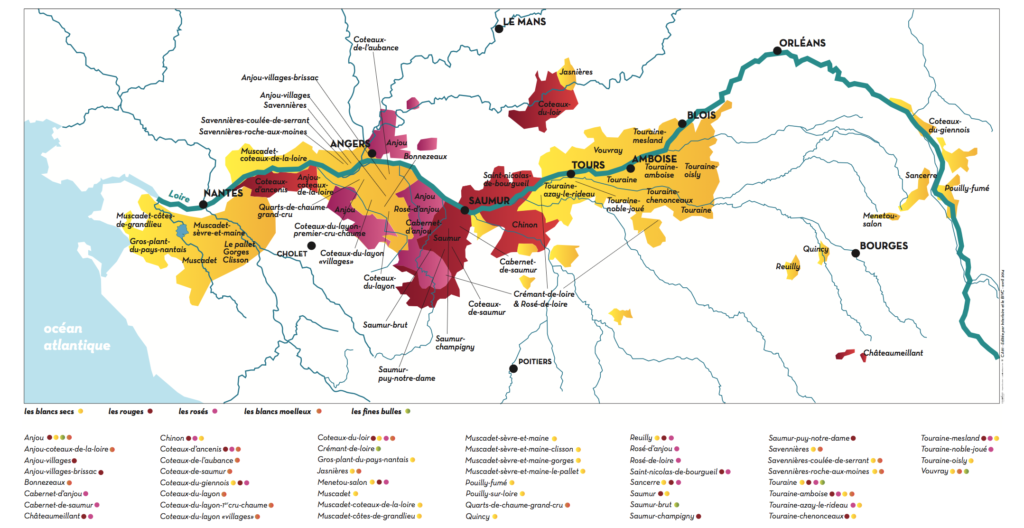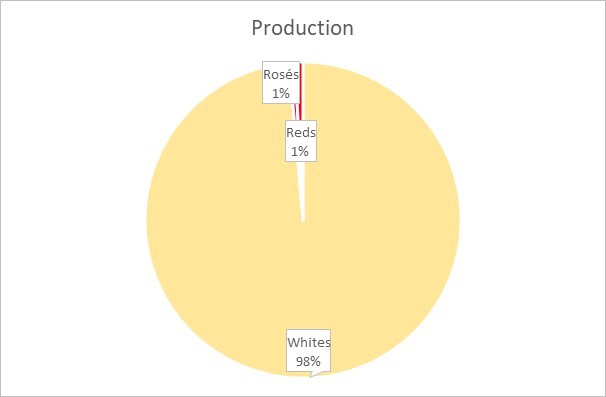You may be familiar with Muscadet, the emblematic wine of Pays Nantais in the Loire, but did you know that this is an area currently undergoing change? We’ve pulled together this fast facts guide to Pays Nantais to give you the lowdown on this region and its wines, including recent developments. Our Pays Nantais wine guide includes: the essentials of terroir (the soil types, climate, average temperatures, rainfall, longitude and latitude, and altitude); the main grape varieties used for different wine varieties; the viticultural methods, winemaking techniques, wine styles and tasting notes; and the production area in size and number of producers.
Where is it?
This is the westernmost Loire sub-region, stretching from just west of Anjou to the Atlantic Ocean.

The Essentials of Terroir
Climate & Landscape
Its proximity to the Atlantic Ocean makes this a temperate area with a maritime influence with mild autumns and winters and hot, often humid summers. There are some 2,000 hours of sun per year.
Temperatures
July is the hottest month in Nantes with an average temperature of 20°C and the coldest is January at 6°C.
Rainfall
Nantes has an average of 788mm of rain per year. The wettest month is January with an average of 100mm of rain.
Soils
The soils are rocky, based on igneous and metamorphic rocks of the Amorican Structure, which contain gneiss, micaschist, greenstone and granite.
Longitude
1.55˚W
Latitude
47.2˚ N
Viticulture Facts & Vineyard Management
Harvesting is early, beginning in mid-September because Melon de Borgogne ripens early.
Maximum yields
- 55hl/ha for Muscadet de Sévre et Main
- 45hl/ha for the new Crus communeaux
- 70hl/ha for Gros Plant du Pays Nantais
Vine Training systems
Mainly Guyot
Pests and Diseases
Melon de Borgogne is subject to downy and powdery mildew and grey rot.
Grape Varieties
[mepr-hide if=”rule: 2080″]
…
Want to learn about:
- Grape Varieties of Pays Nantais
- Winemaking styles of Pays Nantais
- Wines of Pays Nantais
- Pays Nantais appellations and sub-regions
- Production area & statistics from Pays Nantais
- and more interesting facts on Pays Nantais?
This content is exclusive for Members. Take a look at the introductory packages below to become a Member of 80 Harvests and get unrestricted access to all our content.
Thank you for supporting the journey and being part of the 80 Harvests community!
[mepr-group-price-boxes group_id=”2070″]
[/mepr-hide]
[mepr-show if=”rule: 2080″]
Melon de Borgogne
This is by far the most grown grape in this area. It is a white variety which is resistant to the cold, though as it buds early, the frost can damage its shoots. It is not particularly acidic or strongly flavoured and tends to make neutral wines.
Folle Blanche (Gros Plant)
This white grape variety originates from the Southwest region and is used to produce Gros Plant-du-Pays-Nantais.
Gamay
This black variety is grown in the Coteaux-d’Ancenis area and makes ripe, fruity reds and rosés.
Wine Varieties & Winemaking Styles
Most of the wine made in this region is white, with Muscadet being the most common. Muscadet is based on a single variety of grape – Melon de Borgogne, which, as the name suggests, can also be found in Burgundy. Muscadet is a simple, tangy, almost refreshingly salty wine to be enjoyed young. It can have a touch of spritz because of being bottled with a small amount of carbon dioxide still in the wine.
Traditionally many Muscadet wines were very neutral, but these days some much more interesting wines are being produced. Some winemakers are using techniques like skin contact, lees stirring and even fermenting the wine in neutral oak barrels and these are resulting in wines with more weight and richness.
Muscadet sur lie has more body and flavour because it has spent time over its lees (the sediment from the winemaking). To be labelled as “sur lie”, the wine can be racked once to remove the largest sediment particles (gross lees) but after this, the wine must stay in contact with its lees for the whole winter following the vintage. It can only be filtered just before being bottled. There are two bottling periods, both in the year following the vintage : between 1 March and 30 June or between 15 October and 30 November. Muscadet sur lie most often comes from Muscadet-Sèvre-et-Maine, Muscadet-Coteaux-de-la-Loire and Muscadet-Côtes-de-Grandlieu.
Gros Plant du Pays Nantais is made from Folle Blanche (known here as Gros Plant) grapes, sometimes blended with Colombard. This is a pale straw-coloured wine which is floral and fruity with high acidity, which can be very tart, and light body. When aged “sur lie” (following the same rules as for Muscadet sur lie), the wine is suppler.
Reds and rosés are produced from Gamay in the Coteaux-d’Ancenis appellation. These wines are cherry red or vibrant pink in colour and have red fruit aromas and a fruity taste.
Appellations and new denominations
There are 6 appellations in Pays Nantais:
Muscadet
Muscadet-Coteaux-de-la-Loire
Muscadet-Côtes-de-Grandlieu
Muscadet-Sèvre-et-Maine
Coteaux-d’Ancenis (red and rosé wines from Gamay and whites from Malvoisie)
Gros-Plant-du-Pays-Nantais. This appellation covers the whole Pays Nantais area and is specific to the type of wine rather than a defined area. These are white wines made from Folle Blanche, which can also be “sur lie”.
Quality levels
Muscadet-Sèvre-et-Maine, Muscadet-Coteaux-de-la-Loire and Muscadet-Côtes-de-Grandlieu have generally been considered a slightly superior quality to generic Muscadet and are often “sur lie”.
New communal cru denominations
Now there is a new top quality tier in Pays Nantais. In 2011, three communal crus (crus communaux) were approved and another 4 are expected to be approved during 2017. These are all defined geographical areas that have been singled out because of their soil types.
The 3 communal crus approved in 2011 are:
- Clisson, which has soils based on granite
- Gorges, with clay and quartz
- Le Pallet has gabbro (like basalt, but with coarse-grained crystals), gneiss and sandstone.
The 4 communal crus expected this year are:
- Goulaine, on schist soils
- Mouzillon Tillières, like Le Palle has gabbro
- Monnières Saint-Fiacre has soils based on gneiss
- Château Thébaud has granitic soils.
To be able to use the communal cru on the label, winemakers must comply with tougher production rules. For instance, yields are limited to 45hl/ha (compared to 55hl/ha for Muscadet-Sèvre-et-Maine). These wines spend much longer in contact with their lees, having at least 17 months’ ageing but often much more. Ironically this means they cannot be labelled ‘sur lie’, as they spend longer than the time stipulated,
Traditional Wine Pairing
Muscadet works well with seafood. Suggested pairings are crab quiche, salad or the local goat’s cheese, Tomme de chevre de Muscadet.
Production Area
9,000 ha
Number of Producers
Producers: 600
Cooperative wineries: 2
Négociants: 50
Annual Production (average)
Average of 450,000 hl
The different Muscadet appellations produce 422,300 hl, broken down as follows:
- 300,000 hl = Muscadet-Sèvre-et-Maine
- 99,500 hl = Muscadet AOC
- 13,100 hl = Muscadet-Côtes-de-Grandlieu
- 7,500 hl = Muscadet Coteaux de la Loire
- 900 hl = Muscadet-Sèvre-et-Maine – Clisson
- 800 hl = Muscadet-Sèvre-et-Maine – Gorges
- 500 hl = Muscadet-Sèvre-et-Maine – Le Pallet
The other Pays Nantais appellations produce 50,000 hl, divided as follows:
- 42,300 hl = Gros Plant du Pays Nantais
- 7,700 hl = Coteaux-d’Ancenis

Interesting Facts
To the north-west of Nantes and the Muscadet wine region is Gérande, a Medieval town surrounded by 7 miles of marshes, where salt has been harvested for centuries. In the 13th century, ships carrying salt from Gérande also loaded some of the local wine, thereby encouraging the development of viticulture in the area. Today, around 10,000 tonnes of coarse salt are produced each year, of which 300 tonnes are fleur de sel, which is highly prized by chefs.
More information from the Official Website for Tourism in France.
[/mepr-show]
Sources of information:
Val de Loire official tourism site – source of the statistics used in this post and the photo above
Clarke, O. & Rand, M. Grapes and Wines. 2015 edition. London: Pavilion.
Robinson, J., 2015. The Oxford Companion to Wine. 4th Ed. Oxford: Oxford University Press.

